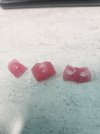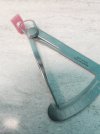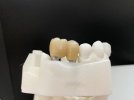Most of the splitting I see is the result of physical damage after printing, splitting with time from passive UV degradation isn't an issue because working models just don't hang around for that long. We use Keystone Mask on Asiga Maxes, post-cure with Dreve PCU LEDs under vacuum, btw- Otaflash curing for these seems less consistent, even with the shielding gas.
- Limiting how 'tall' your unsupported thin sections are,
- keeping your wash times as short as possible,
- handling them gently at all times, and most importantly,
- Printing everything in duplicate (or triplicate if it's a really tricky bit of gingiva)
Is my working theory here.
What this typically means is carefully hand-washing parts with soft natural bristle brushes in a small tray of IPA and then drying immediately with warm air vs. chucking them into an impeller wash unit that'll tumble them around for several minutes. Handling them with tongs can also help if you're clumsy in gloves like I am. I've also tried connecting large numbers of gingiva together in sprue-linked 'rafts' that you can create in Prusa Slicer, so they stay put in the wash and you can handle them as a single unit without damaging them, then separating them after post-curing for assembly, but it isn't really worth the extra work most of the time.
I also started working on a 'supportive mandrel' for gingiva with particularly delicate sections, basically a printed plug with the same geometry as the gingiva's hollow sections that you insert to support them internally and also serve as a little handle for moving them about, but it wasn't worth the effort of removing them all so the UV post-cure can reach the interior cavities.
That said, I stopped bothering with all the gimmicky measures when I realized it's cheaper and faster to just run one or two back-up parts, at least one of them will usually come out gnarly but you almost always get an acceptable one.





